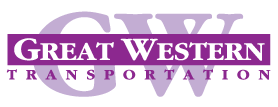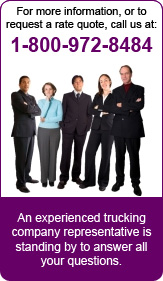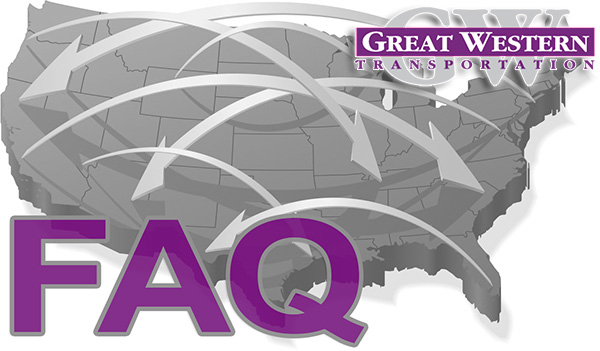Q: Can I ship smaller freight or product quantities without having to pay for a whole truck?
Q: I have more than a Truckload volume quantity of freight or product, what can I do?
Q: Will frozen freight or product be more expensive to ship than refrigerated freight or product?
Q: If I ship a truckload, how many pallets can I fit in the trailer?
Q: How will my shipment be transported with a Less Than Truckload (LTL) Freight Carrier?
Q: How will my shipment be transported with a Full Truckload (FTL) Freight Carrier?
Q: What do I need to do after scheduling my shipment?
Q: What if my shipment is not ready when the trailer and driver arrive?
Q: Does the shipment weight have to be accurate or can I estimate the weight?
Q: What is Dimensional Weight?
Q: What are Accessorial Charges (also called “Assessorial Charges”) that may apply?
Q: What is the best way to package my shipment?
Q: Can I ship smaller freight or product quantities without having to pay for a whole truck?
A: Yes, “LTL” which stands for “Less Than Truckload” is very common for smaller freight or product quantities. You can ship 1 box, 1 pallet, 5-10 pallets etc. without paying for a full truckload. Great Western Transportation can cover all your shipping needs within the US and Canada, no matter what the volume of shipping freight or product is, whether large or small we will transport all your freight volume quantities.
Q: I have more than a Truckload volume quantity of freight or product, what can I do?
A: This is not a problem! We will fill one truckload to the legal limit with your product or freight, and send the overflow portion as Less Than Truckload (LTL) shipment.
A: Yes. We call this master billing. If you have orders for multiple consignees (receiving party) shipping the same day, you may qualify for our master billing program where you’re charged for the total gross weight shipped plus additional stop fee rather than shipping each order individually. This applies to shipments with one pickup and multiple destinations as well as multiple pickups delivering to 1 consignee.
A: Yes. If you don’t qualify for credit, we have prepayment options available.
Q: Will frozen freight or product be more expensive to ship than refrigerated freight or product?
A: No. We try to keep our pricing very fair and standard across the board. There is no extra charge for shipping frozen freight or product.
Q: If I ship a truckload, how many pallets can I fit in the trailer?
A: The standard fleet of 53′ trailers can hold up to 30 (standard 40×48) pallet positions if they can be loaded sideways, don’t hang over the pallet edges and don’t exceed the legal weight limits. When shipping high cube loads, more pallets means less weight per space. As an example, with a 24 pallet order weighing 42,500 lbs, we can single pallets in the front and back of the trailer to ensure we don’t exceed the axle weight regulations. If you ship a 28-30 pallet order, you will not be able to single any pallets or control your weight distribution if all your pallets are the same weight. This increases the risk of being too heavy in the front or back of the trailer. We recommend with loads over 40,000 gross lbs. that you try to ship in 26 pallet positions or less.
If a forklift is unavailable and your pallets cannot be rotated and loaded sideways, our 53′ trailers can hold 26 (standard 40×48) pallet positions loaded straight into the trailer and 24 (standard 40×48) pallet positions for 48′ trailers.
Our freight consultant will assist you in determining the ideal pallet weight.
Q: How will my shipment be transported with a Less Than Truckload (LTL) Freight Carrier?
A: Your shipment will be transported on a trailer along with other customer’s shipments. This allows for the costs of transportation to be split among the freight shippers which makes Less Than Truckload (LTL) transportation economical and affordable to freight shippers that have smaller freight volumes.
Q: How will my shipment be transported with a Full Truckload (FTL) Freight Carrier?
A: If your shipment is large enough to take up the entire truck space, it is a “full truckload” and will be transported in the trailer all by itself. A Full Truckload (FTL) shipment can range from 5000 lbs and up, although some Full Truckload (FTL) carriers have a minimum weight requirement of 10,000 lbs or more. If your shipment does not quite require the entire space, it is considered a “partial truckload” and will be transported via truck along with another partial load.
Q: What do I need to do after scheduling my shipment?
A: Print 2 copies of the Bill of Lading and be sure your shipment is properly packaged and ready for transport. On the designated pick up day have your freight ready and the 2 copies of the Bill of Lading. Give 1 copy of the Bill of lading to the driver, this Bill of Lading goes along with the shipment and the other copy has to be signed by the driver, with pro label affixed, this copy you to keep in your files. You may also consider sending the consignee (receiving party) a copy of the bill of lading too, so that they will be aware of the shipment arriving at their location.
Q: What if my shipment is not ready when the trailer and driver arrive?
A: Generally the driver will not wait and will be dispatched to come out again the next day or at another time . This will delay your transit time and you will be responsible for a duplicated pick up fee for the 2nd pick up. Please have your shipment ready for the driver on time.
A: Freight Class refers to the National Motor Freight Classification (NMFC) and it is the category of your freight as defined by the National Motor Freight Traffic Association (NMFTA). Your shipment’s freight class determines the carrier’s shipping charges. Commodities are grouped into one of 18 classes, from a low of class 50 (the least expensive) to a high of class 500 (most expensive), based on an evaluation of four transportation characteristics: density, stow ability, handling and liability. Together, these characteristics establish a commodity’s transportability. The class of your shipment is determined by its contents and NMFC item number.
To determine your freight class these are the questions that need be answered:
- What is the description of the item that is being shipped?
- Of what material(s) is your product made?
- How is it used?
- How is it packaged?
- What is the accurate dollar value of the item?
- What is the density of the item? Note: Calculate density by comparing the weight of an item with the volume of space that it takes up (pounds / cubic feet).
- What is the conditions of the item new or used?
Q: Does the shipment weight have to be accurate or can I estimate the weight?
A: Yes, the total shipment weight has to be accurate because your shipping charge is based partly on weight. If your shipment weight is not correct, it is subject to being re-weighed, which may result in an additional charge. Re-weighing may cause possible delivery delays.
Q: What is Dimensional Weight?
A: Dimensional weight (also referred to as “dim” weight) takes into consideration a package’s density, which is the volume of space a package takes up in relation to its actual weight. Dimensional weight is used when packages are large in volume, but do not weigh that much relative to their volume. For example, the shipping charge of a large box of popcorn or inflated balloons may be based on the dimensional weight because of the amount of space it takes in a trailer.
Q: What are Accessorial Charges (also called “Assessorial Charges”) that may apply?
A: There are two other Accessorial Charges that may apply see below.
Inside Pick up & Inside Delivery fees: If the driver is required to go inside the location (inside the premises past the front door or loading dock), to pick up or deliver your shipment. Generally the driver will stay at the dock or with the trailer. In such cases an additional fee will be added for these extra services that will be provided. When obtaining quotes through our representatives, notify the representative of the inside pick up and or inside delivery and the carrier’s fee will be included in your final quotes.
Lift gate service fee: When the origin or destination location of the shipment does not have a loading dock, then manual loading or unloading is necessary. This requires a lift or rail gate, which is a motorized hydraulic platform attached to the back of some trucks that can raise a shipment from the ground up to the truck trailer or bring the shipment from the trailer down to the ground. When obtaining your quotes through our representative, notify the representative of the lift or rail gate requirement and the carrier’s lift or rail gate fee will be included in your final quotes.
Q: What is the best way to package my shipment?
A: Your shipment should be packaged in a way to ensure that the contents can be delivered safely and without damage. Improper packaging may void the carrier’s liability for any damage that may occur to the freight or product. Please refer to our packaging guidelines & tips for help with proper packaging, crating and using pallets.






